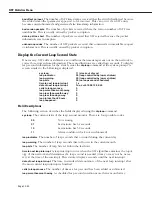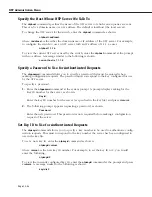
NTP Access Control Menu
Page 12-41
Remove Flags from a Restrict Entry
It is possible to place restriction flags on specific
NTP
entities in relation to the switch. Restric-
tion flags prevent messages or information coming from the
NTP
entity from affecting the
switch.
To remove a restriction flag from an
NTP
entity, enter the
ntpmres
command as shown:
ntpmres <address> <mask> <restriction>
where
<address>
is the
IP
address of the
NTP
entity,
<mask>
is the entity’s subnet mask, and
<restriction>
is the specific flag you want to remove from the entity. For example, to remove
an
ignore
restriction from an entity with address 1.1.1.1 and a subnet mask of 255.255.0.0,
enter the following:
ntpmres 1.1.1.1 255.255.0.0 ignore
Delete a Restrict Entry
To remove an entry completely from the restriction list, enter the
ntpdres
command in the
following manner:
ntpdres <address> <mask>
where
<address>
is the
IP
address of the
NTP
entity, and
<mask>
is the entity’s subnet mask.
For example to remove an entity with address 1.1.1.1 and a subnet mask of 255.255.0.0, enter
the following:
ntpmres 1.1.1.1 255.255.0.0
This entity will no longer be listed in the restriction list and has no restriction flags placed on
messages it sends to the switch.
Configure a Trap in the Server
The
ntpctrap
command allows you to set a trap receiver for the given address and port
number. The trap receiver will log event messages and other information for the server in a
log file.
To create a trap receiver, enter the
ntpctrap
command in the following manner:
ntpctrap <address> [<port>] [<interface>]
where address is the IP address of the switch. There are two optional items you can specify:
port
The port on the switch used for sending
NTP
messages. If no
port is specified, a default port of 18447 is used.
♦
Note
♦
This is the
TCP
and
UDP
definition of a port, not a
switch interface port.
interface
The local interface address for this
NTP
entity. If no interface is
specified, the interface for the local
NTP
entity is used. For
more information on interface addresses, see
Display Peer
Summary Information
on page 12-16.
Summary of Contents for Omni Switch/Router
Page 1: ...Part No 060166 10 Rev C March 2005 Omni Switch Router User Manual Release 4 5 www alcatel com ...
Page 4: ...page iv ...
Page 110: ...WAN Modules Page 3 40 ...
Page 156: ...UI Table Filtering Using Search and Filter Commands Page 4 46 ...
Page 164: ...Using ZMODEM Page 5 8 ...
Page 186: ...Displaying and Setting the Swap State Page 6 22 ...
Page 202: ...Creating a New File System Page 7 16 ...
Page 270: ...Displaying Secure Access Entries in the MPM Log Page 10 14 ...
Page 430: ...OmniChannel Page 15 16 ...
Page 496: ...Configuring Source Route to Transparent Bridging Page 17 48 ...
Page 542: ...Dissimilar LAN Switching Capabilities Page 18 46 ...
Page 646: ...Application Example DHCP Policies Page 20 30 ...
Page 660: ...GMAP Page 21 14 ...
Page 710: ...Viewing the Virtual Interface of Multicast VLANs Page 23 16 ...
Page 722: ...Application Example 5 Page 24 12 ...
Page 788: ...Viewing UDP Relay Statistics Page 26 24 ...
Page 872: ...The WAN Port Software Menu Page 28 46 ...
Page 960: ...Deleting a PPP Entity Page 30 22 ...
Page 978: ...Displaying Link Status Page 31 18 ...
Page 988: ...Displaying ISDN Configuration Entry Status Page 32 10 ...
Page 1024: ...Backup Services Commands Page 34 14 ...
Page 1062: ...Diagnostic Test Cable Schematics Page 36 24 ...
Page 1072: ...Configuring a Switch with an MPX Page A 10 ...
Page 1086: ...Page B 14 ...
Page 1100: ...Page I 14 Index ...






























